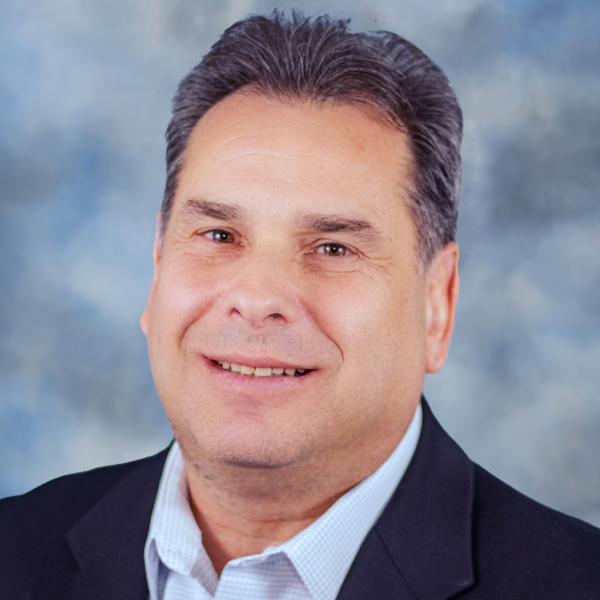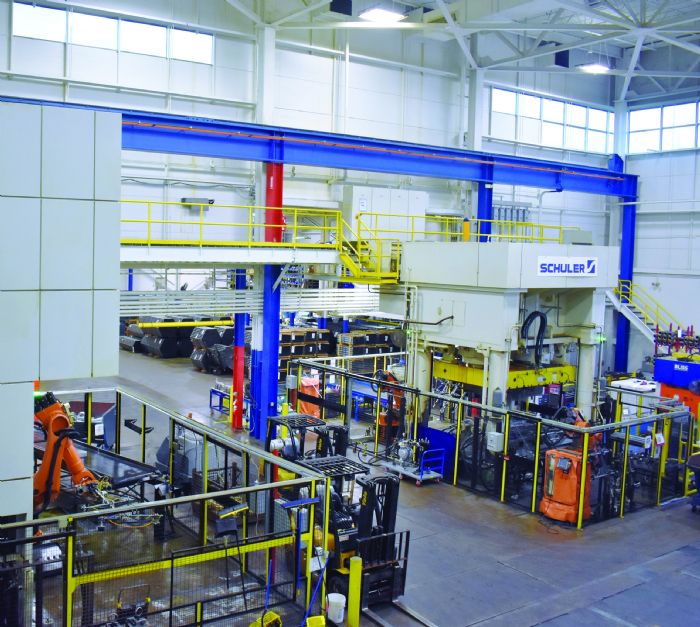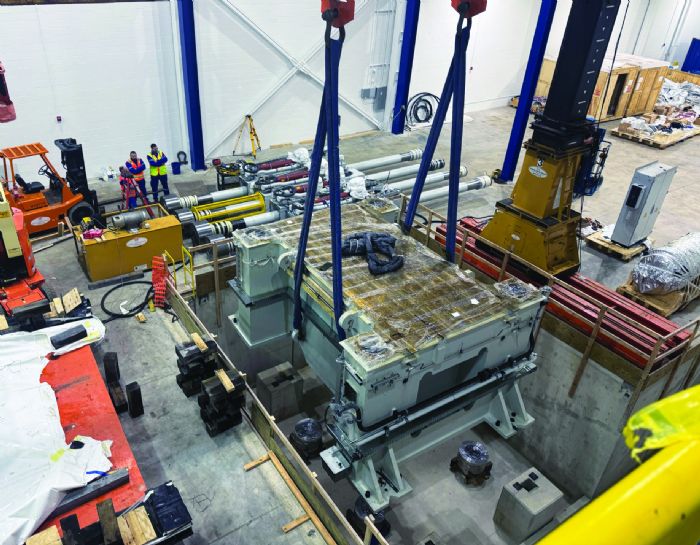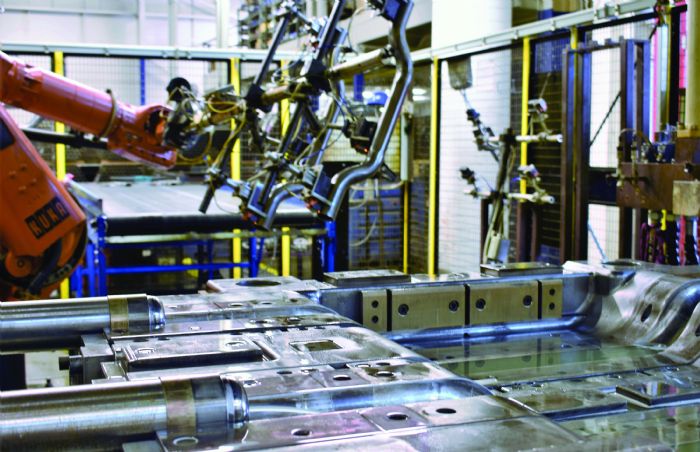Some 75% of the firm’s hydroforming projects start at the Commerce Blvd. facility. The remaining work (two projects specifically—a high-volume automotive lower beam and a low-volume job for an off-highway customer) start at the Ronda facility, which features a self-contained robotic workcell that bends and preforms tubular workpieces. A robot loads and unloads the bender, delivering bent tubes to a preform station. Preformed parts then head to the Commerce Blvd. facility for hydroforming.
|
Commerce Blvd.: 40,500 sq. ft.
The facility also houses tube-bending machines (BLM and YLM models) and employs Kuka robots to handle numerous material-handling tasks, including press load and unload.
Schuler recently completed a 10,000-sq.-ft. addition, the result of a new program earned in 2023 that generated the need for an additional 5000-ton press (manufactured in Brazil at Prensas Schuler), along with a new bending cell and automation. Schuler took delivery of the new press early in 2025 and expects it to be in production by Q2 of 2025. Ronda Dr.: 57,600 sq. ft. The facility also houses a BLM tube-bending machine, a horn bender, Nachi robots, an assembly cell and quality lab. |
Commenting on the previously mentioned off-highway job, Brown says:
“That job is just one example of what we often see—a design with multiple stampings welded into an assembly that looks similar to a tubular section or a modified tubular section, meaning it starts round but could be square or rectangular, trapezoidal or other closed shapes. Often, we can reengineer the shape into one tube that will perform the same function while eliminating the welding operations and potential for distortion. And, the resulting hydroforming process is much more repeatable and robust.
“In addition,” Brown continues, “hydroforming often can eliminate attachment points, because we’re changing the cross section as we move down the length of the tube. A stamped part usually has flanges for welding or assembly. We can eliminate those flanges and look at the part from a structural perspective, redesigning the shape into one section. We then can produce a lighter final part with hydroforming, in part because we can reduce material thickness. We’ve redesigned stamped parts from 2.5 to 3-mm-thick sheet into hydroformed parts from 1.5-mm-thick tube, with the same material properties. The hydroform process often will work-harden the material and produces a higher-strength finished part compared to the base tube material.”
Besides producing lighter components, process consistency and repeatability with hydroforming is improved compared to stamping and welding.
“We also can fit multiple part variations—with completely separate geometries and thickness variations—in one die,” McMahon says. “The same hydroforming tool even can produce parts from various material thicknesses.”
McMahon explains:
“A hydroforming die is more like a mold than a stamping die, because we form using pressure from the inside of the tube and form outward to the die. So, we’re only concerned with the outside of the tube, not the inside of the sheet as with a stamping, where the key issue is material thinning and final thickness. We’re only concerned with the outside shape of the tube.
“We have a couple of jobs where we run the same part design at two different thicknesses in the same die,” he continues. “Again, the off-highway part is one example, which started with 8-mm-thick tube and then moved to 6- and 4-mm-thick. With the tubular hydroforming process we can run all of those material thicknesses in the same die, with minimal changes to process parameters.”
Multi-Out Cavities
Further evidence of hydroform-process flexibility: multi-part-out die cavities. “For example, for one job we hydroform two parts with slightly different geometries for the same vehicle model, one for an electric and the other for a combustion-engine version,” Brown explains. “In other cases, we hydroform left- and right-side parts, all in the same die.”
Describing the hydroforming process, Brown notes that the process parameters critical to success are pressure inside of the tube and the press tonnage required.
“After the tube is loaded into the press, the ram indexes down to a set position in relation to top or bottom dead center (BDC),” he says. “Then we fill the tube with water, monitoring to ensure that we have a sufficient flow of water. Then the ram begins to close while we close off the tube ends with sealing cones and create a closed chamber. At BDC, we build tonnage in the die, intensify the water pressure inside of the tube, and then perform any hole piercing that is required. We then release the water pressure, retract the piercing and sealing cylinders, and open the press. Cycle time averages in the 25 to 40-sec. range. All of these actions have a parameter-tolerance window, so that the process aborts if any parameter falls out of tolerance.”
A final thought from McMahon:
“In addition to operating our own hydroforming operation here in Canton, we also have numerous customers that use Schuler hydroforming presses in their own facilities,” he says. “Our process knowledge and experience allow us to work with a customer’s engineering team to identify opportunities to use the hydroforming process. And we have an international network of engineers we can lean on as well, to support our efforts to manage projects from design, engineering and production. That includes process simulations—we’re one of just a few companies in North America that run AutoForm’s TubeXpert design and simulation software for tube bending, forming and simulation software. In fact, some of our customers ask us to run simulations for them. And, we design and manufacture tooling as well, including running 300-piece buyoff runs on our presses for customer approval, and performing 30-piece capability studies.
“Even when a job will not run production here in Canton,” he concludes, “we still can prove out the process and ensure that the parts meet requirements—we do that for every tool we build.” MF
View Glossary of Metalforming Terms
See also: Andritz Schuler
Technologies: Stamping Presses







 “The hydroforming process also can improve consistency in precision and quality,” explains Chris McMahon, hydroforming sales manager at Schuler North America, which maintains hydroforming operations out of two facilities in Canton, MI. “Hydroforming can consolidate several parts that may have been stampings and weldments into one complete part. For example, working on an off-highway-vehicle project, we were able to convert an assembly of several different parts into one hydroformed tube—an ongoing project that has been in production for more than 10 yr.”
“The hydroforming process also can improve consistency in precision and quality,” explains Chris McMahon, hydroforming sales manager at Schuler North America, which maintains hydroforming operations out of two facilities in Canton, MI. “Hydroforming can consolidate several parts that may have been stampings and weldments into one complete part. For example, working on an off-highway-vehicle project, we were able to convert an assembly of several different parts into one hydroformed tube—an ongoing project that has been in production for more than 10 yr.” Schuler’s hydroforming operations comprise a 40,500-sq.-ft. facility on Commerce Dr. (including a newly completed 10,000-sq.-ft. addition) housing with four presses, along with an array of tube-bending machines; and a 57,600-sq. ft. facility nearby on Ronda Dr., with robot-tended tube benders, a pair of Trumpf five-axis laser-cutting cells, assembly cells and a quality lab. Its engineers provide customers with extensive expertise in forming parts from aluminum and steel grades, including advanced high-strength dual-phase steels.
Schuler’s hydroforming operations comprise a 40,500-sq.-ft. facility on Commerce Dr. (including a newly completed 10,000-sq.-ft. addition) housing with four presses, along with an array of tube-bending machines; and a 57,600-sq. ft. facility nearby on Ronda Dr., with robot-tended tube benders, a pair of Trumpf five-axis laser-cutting cells, assembly cells and a quality lab. Its engineers provide customers with extensive expertise in forming parts from aluminum and steel grades, including advanced high-strength dual-phase steels.  Schuler launched its North American hydroforming operations in 2000. It now operates from two facilities in Canton, MI:
Schuler launched its North American hydroforming operations in 2000. It now operates from two facilities in Canton, MI:
 Video
Video